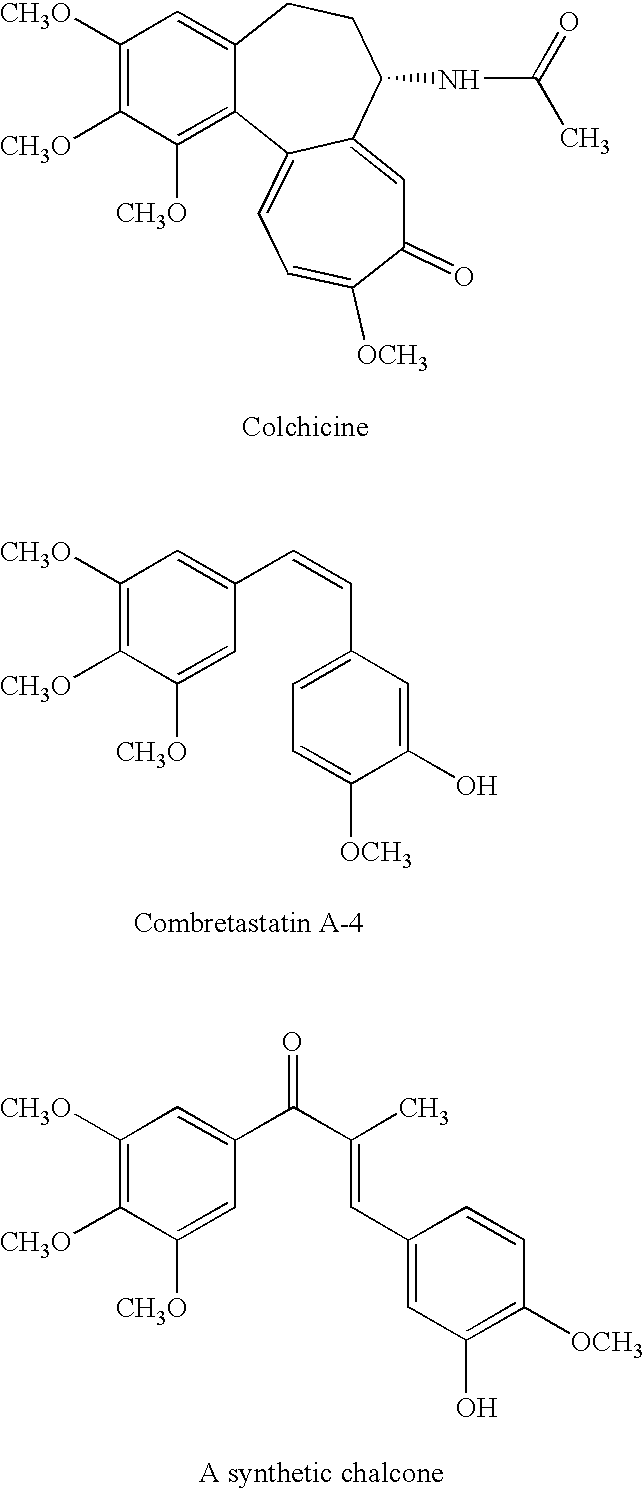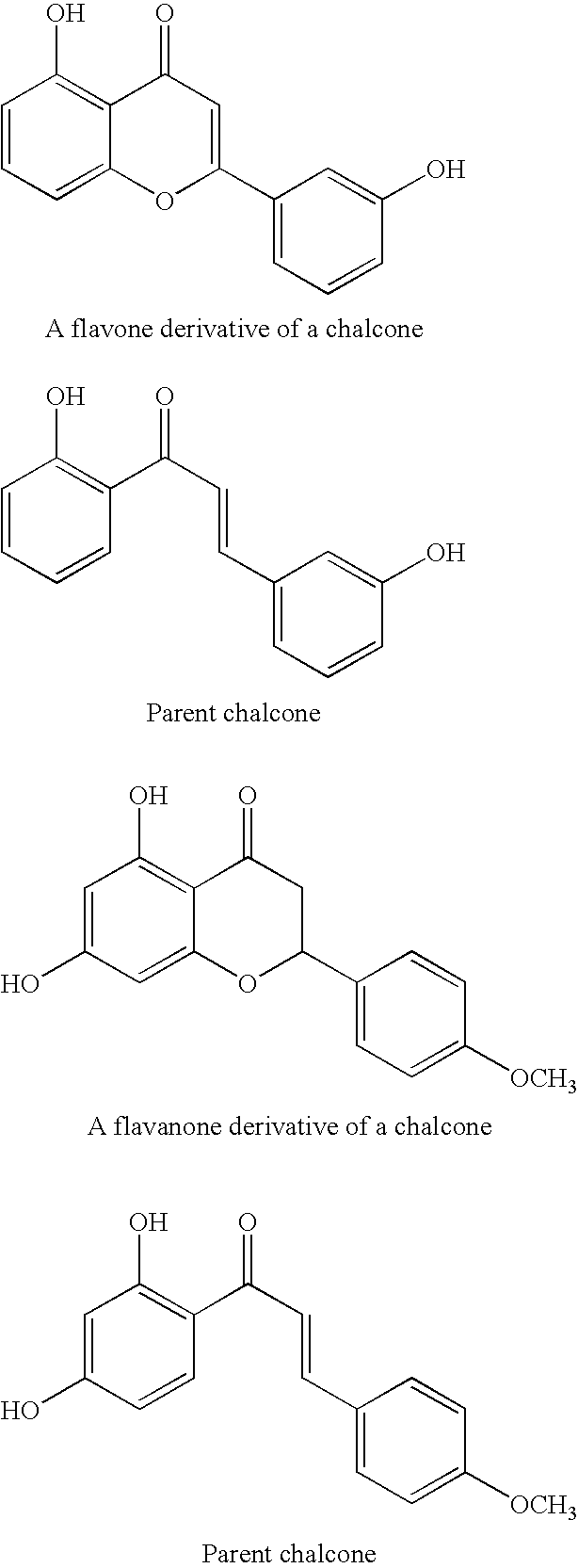Modified chalcone compounds as antimitotic agents
a technology of chalcone compound and antimitotic agent, which is applied in the field of antimitotic agent, can solve the problems of drug ineffective or mitigating treatment benefit, broad classes of antitumor drugs are expelled, and drug classes are no longer useful for treatment, so as to enhance the ability to ionize and react with electrophilic groups.
- Summary
- Abstract
- Description
- Claims
- Application Information
AI Technical Summary
Benefits of technology
Problems solved by technology
Method used
Image
Examples
example 1
Preparation of 3-[3-(Crotonylsulfanylmethylcarbonyloxy)-4-methoxyphenyl]-1-(3,4,5-trimethoxyphenyl)propenone (CMAC-1) and its Activity Against Cancer Cell Growth
[0164]The method of synthesis of CMAC-1 (entry 1 of Table 1) is summarized in Scheme 1.
[0165]
[0166]Chalcone CMAC-1 was synthesized by esterification of the known chalcone 1 (S. Ducki, R. Forrest, J. A. Hadfield, A. Kendall, N. J. Lawrence, A. T. McGowan, and D. Rennison, Bioorg. Med. Chem. Lett., 1998, 8, 1051-1056), itself formed from 3,4,5-trimethoxyacetophenone and 3-hydroxy-4-methoxybenzaldehyde. Chalcone 1 (0.49 g, 1.42 mmol) was dissolved in 20 mL distilled dichloromethane, and the solution was chilled to 0° C. and placed under N2. To this solution were added 0.27 g (1.70 mmol, 1.2 equiv.) of but-2-enoylsulfanylacetic acid, 17 mg (0.14 mmol, 0.1 equiv.) of 4-dimethylaminopyridine (DMAP), and 0.325 g (1.70 mmol, 1.2 equiv.) of 1-(3-dimethylaminopropyl)-3-ethylcarbodiimide hydrochloride (EDAC—HCl). The reaction mixture w...
example 2
Preparation of 3-[5-(Crotonylsulfanylmethylcarbonyloxymethyl)-2-furyl-1]-(3,4,5-trimethoxyphenyl)propenone (CMAF-1) and its Activity Against Cancer Cell Growth
[0173]The method of synthesis of CMAF-1 (entry 11 of Table 1) is summarized in Scheme 2.
[0174]
[0175]Preparation of Chalcone 2 was accomplished by Claisen-Schmidt condensation, as follows. In 5 mL methanol were dissolved 1.43 g (6.8 mmol) of 3,4,5-trimethoxyacetophenone and 1.14 g (6.8 mmol) of 5-acetoxymethyl-2-furaldehyde. After addition of 0.37 g crushed NaOH, the reaction mixture was stirred overnight to yield a dark solid material. This was taken up in methanol, collected by filtration, and washed with ice water to yield a mustard yellow powder (1.35 g, 55%). The material was recrystallized from H2O-methanol. Mp 86-88° C. 1H NMR (CDCl3) δ (ppm) 2.2 (br s, 1H), 3.93 (s, 3H), 3.95 (s, 6H), 4.70 (s, 2H), 6.42 (d, J=3.3 Hz, 1H), 6.67 (d, J=3.3 Hz, 1H), 7.28 (s, 2H), 7.38 (d, J=15.3 Hz, 1H), 7.56 (d, J=15.6 Hz, 1H).
[0176]Esteri...
example 3
Activity against Cancer Cell Growth of 3-[3-(2-Chloroacryloyloxy)-4-methoxyphenyl]-1-(3,4,5-trimethoxyphenyl)propenone
[0179]3-[3-(2-Chloroacryloyloxy)-4-methoxyphenyl]-1-(3,4,5-trimethoxyphenyl)propenone (entry 6 of Table 1). Mp 120-121° C. Anal. (%) Calcd. for C21H21ClO7: C, 59.93; H, 5.03. Found: C, 60.08; H, 5.04. 1H NMR (300 MHz, CDCl3) δ (ppm) 3.86 (s, C(4′a)OCH3), 3.91 (s, C(4a)OCH3), 3.93 (s, C(3a)OCH3 and C(5a)OCH3), 6.20 (d, J=2.0 Hz, CClCHH), 6.76 (d, J=3.0 Hz, CClCHH), 7.00 (d, J=8.1 Hz, C(3′)H), 7.24 (s, C(2)H, C(6)H), 7.32 (d, J=15.6 Hz, O═CCHCH), 7.43 (d, J=2.1 Hz, C(6′)H), 7.50 (dd, J=8.4, 2.1 Hz, C(2′)H), 7.73 (d, J=15.3 Hz, O═CCHCH). 13C NMR (100 MHz, CDCl3) δ (ppm) 56.2 (C(4′a)OCH3), 56.5 (C(3a)OCH3 and C(5a)OCH3), 61.0 (C(4a)OCH3), 106.0 (arom C(2), C(6)), 112.5 (arom C(3′)), 120.5 (O═CCHCH), 121.5 (arom C(6′)), 127.7 (CCl═CH2), 128.1 (arom C(1′)), 129.1 (arom C(2′)), 130.6 (CCl═CH2), 133.6 (arom C(1)), 139.8 (arom C(5′)), 142.1 (arom C(4)), 143.3 (O═CCHCH), 152.8...
PUM
| Property | Measurement | Unit |
|---|---|---|
| wavelength | aaaaa | aaaaa |
| concentration | aaaaa | aaaaa |
| covalent | aaaaa | aaaaa |
Abstract
Description
Claims
Application Information
 Login to View More
Login to View More - R&D
- Intellectual Property
- Life Sciences
- Materials
- Tech Scout
- Unparalleled Data Quality
- Higher Quality Content
- 60% Fewer Hallucinations
Browse by: Latest US Patents, China's latest patents, Technical Efficacy Thesaurus, Application Domain, Technology Topic, Popular Technical Reports.
© 2025 PatSnap. All rights reserved.Legal|Privacy policy|Modern Slavery Act Transparency Statement|Sitemap|About US| Contact US: help@patsnap.com



